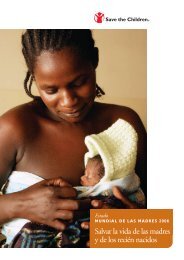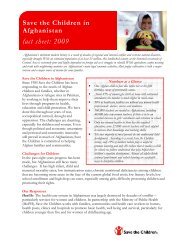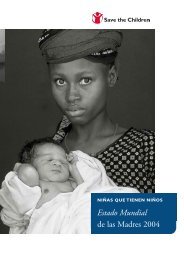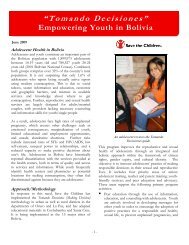Annual Report 2002 - Save the Children
Annual Report 2002 - Save the Children
Annual Report 2002 - Save the Children
Create successful ePaper yourself
Turn your PDF publications into a flip-book with our unique Google optimized e-Paper software.
A YEAR OF DANGER FOR CHILDREN<br />
Every year, children around <strong>the</strong> world are thrust into unsafe conditions that threaten <strong>the</strong>ir<br />
health and safety.<br />
Whe<strong>the</strong>r it’s an earthquake, a flood, armed conflict or some form of abuse, it is children who<br />
are <strong>the</strong> most vulnerable and <strong>the</strong> most frequently endangered. From conflicts in Afghanistan<br />
and <strong>the</strong> Middle East to drought in Africa to terrorism in our own country, millions of children<br />
found <strong>the</strong>mselves in harm’s way during this past year.<br />
<strong>Save</strong> <strong>the</strong> <strong>Children</strong>’s priority in responding to such emergencies and<br />
crises is first to meet <strong>the</strong> immediate, lifesaving needs of children and<br />
<strong>the</strong>ir families by providing food, water, health care and shelter, as well as<br />
protection from exploitation and abuse. Also critical is <strong>the</strong> psychological<br />
and social support that helps <strong>the</strong>m to cope with trauma, injury and<br />
dislocation.<br />
At <strong>the</strong> same time, <strong>Save</strong> <strong>the</strong> <strong>Children</strong> works to restore or establish<br />
programs in health, education and income generation to help children<br />
and families rebuild <strong>the</strong>ir lives and livelihoods and to ensure long-term<br />
recovery and rehabilitation.<br />
Malawi<br />
An estimated half-million families<br />
have been supplied with corn<br />
delivered by <strong>Save</strong> <strong>the</strong> <strong>Children</strong> to<br />
distribution centers like this one<br />
at Monkey Bay.<br />
< Malawi<br />
Malawi<br />
MSNBC-TV’s<br />
Brian Williams<br />
reported on <strong>Save</strong><br />
<strong>the</strong> <strong>Children</strong>’s food<br />
distribution center<br />
in Mangochi<br />
District.<br />
FEEDING AND CARING FOR THE<br />
HUNGRY IN AFRICA<br />
More than 12 million people throughout several countries<br />
in sou<strong>the</strong>rn and eastern Africa are facing <strong>the</strong> worst food<br />
emergency in 10 years as a result of two consecutive years<br />
of irregular rainfall and major crop failures, regional<br />
economic difficulties and <strong>the</strong> depletion of grain reserves.<br />
Noting <strong>the</strong> sharp increase in severely malnourished<br />
children, school absenteeism and <strong>the</strong> depletion of family<br />
income and assets to purchase food, <strong>Save</strong> <strong>the</strong> <strong>Children</strong> was<br />
<strong>the</strong> first to begin disaster relief efforts in Malawi. An<br />
outbreak of cholera and <strong>the</strong> widespread devastating impact<br />
of HIV/AIDS have greatly exacerbated <strong>the</strong> crisis. The<br />
current situation in Ethiopia threatens to be as deadly<br />
as <strong>the</strong> famine that spawned a worldwide anti-hunger<br />
campaign in <strong>the</strong> mid 1980s.<br />
In Malawi, where <strong>Save</strong> <strong>the</strong> <strong>Children</strong> has been active<br />
for many years and where as much as 70 percent of <strong>the</strong><br />
population is unable to meet family food needs, <strong>the</strong> agency<br />
distributed fortified blended foods and maize to <strong>the</strong> most<br />
vulnerable portions of <strong>the</strong> population. This comprised an<br />
estimated 500,000 families caring for orphans and<br />
chronically ill relatives as well as households headed by<br />
children or <strong>the</strong> elderly.<br />
<strong>Save</strong> <strong>the</strong> <strong>Children</strong> also helped tens of thousands in<br />
Zimbabwe and Zambia with support for food distribution,<br />
<strong>the</strong>rapeutic feeding programs, vaccinations, Vitamin A<br />
supplements, <strong>the</strong> training and supervising of local health<br />
workers and o<strong>the</strong>r related health services. In Ethiopia, <strong>Save</strong><br />
<strong>the</strong> <strong>Children</strong> is working to improve access to safe water, to<br />
provide food to families where <strong>the</strong> shortages are acute and<br />
to develop alternative means of generating income.<br />
Much of this effort was made possible through <strong>Save</strong> <strong>the</strong><br />
<strong>Children</strong>’s Halaby-Murphy Fund, created to provide<br />
urgently needed disbursements at <strong>the</strong> very onset of an<br />
emergency, and through a series of emergency response<br />
grants from <strong>the</strong> Bill & Melinda Gates Foundation.<br />
Throughout <strong>the</strong> year, <strong>Save</strong> <strong>the</strong> <strong>Children</strong> also partnered<br />
with <strong>the</strong> ministries of agriculture and local nongovernmental<br />
organizations in Malawi and Mozambique to provide<br />
supplies of improved, drought-resistant varieties of vegetable,<br />
maize and cassava seeds, as well as to train community<br />
leaders to better manage <strong>the</strong>ir resources, establish long-term<br />
food sufficiency and prepare for future food emergencies.<br />
SAVE THE CHILDREN 5




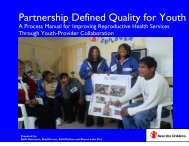

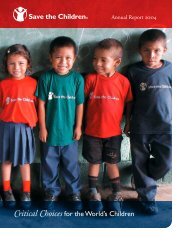
![View full document [PDF 3.39 MB] - PreventionWeb](https://img.yumpu.com/27308954/1/190x245/view-full-document-pdf-339-mb-preventionweb.jpg?quality=85)
